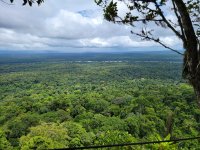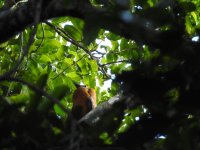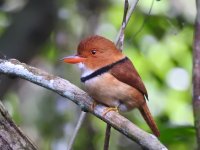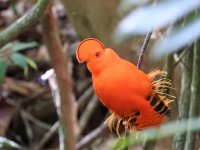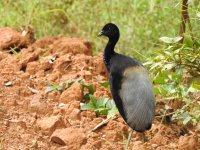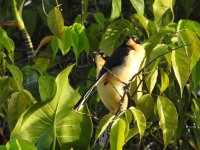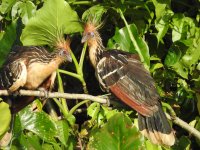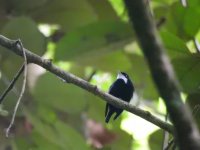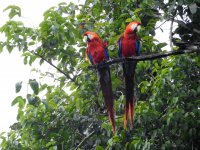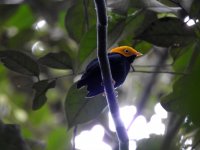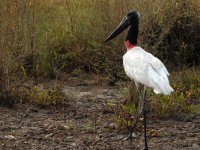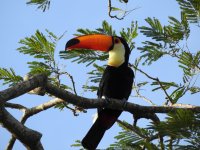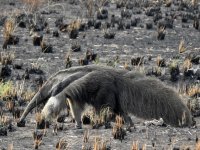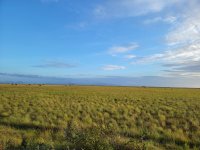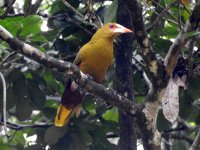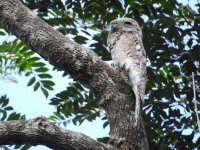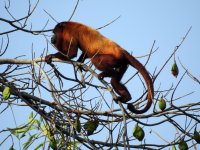lgonz1008
Well-known member

With only 10 days of birding on a 12-day whirlwind trip through Guyana, I can only say that this is probably one of the most underrated places in South America for birding that can cater not just to the veteran birder, but the Neotropic newcomer as well. This was my first trip to South America and I can only say that I was able to see 340 of the 364 species recorded on this trip and a great 240 of which were lifers! Some highlights included all 6 species of Cracids, brief views of the Rufous-winged Ground-Cuckoo, lekking Capuchinbird and Guianan Cock-of-the-Rock, seeing 5 Potoo species within a 24-hour period and having 3 different owl species calling (2 were seen) within earshot of our bed in Atta Lodge. On the mammal front, over a dozen mammal species were identified including two of South America’s giants, the Giant Anteater and the Giant Otter.
Before the detailed itinerary I would like to thank our guide Leon Moore from Leon Moore Nature Experience, this man is easily Guyana’s number one birder along with being one of the eBird reviewers of the country, so any rare sightings were automatically approved by the reviewer who saw it! He put together an itinerary that catered to our budgetary constraints and helped three birders with varying experience in the Neotropics find their targets. His ID skills both by sight and hearing are second to no guide I’ve ever had the pleasure of birding with and he will go out of his way to make sure you get the bird you want, whether that is the rare Rufous-winged Ground-Cuckoo all the way to the widespread (and embarrassing I still hadn’t seen it) Ferruginous Pygmy-Owl.
Detailed Itinerary:
February 9-10 (Flight, drive to the interior and first day in Iwokrama River Lodge)
All three participants left from Miami on the same flight and arrived to Guyana in the middle of the night. We were greeted by Leon outside of the airport and began a long and bumpy ride to the interior. Only thing of note was brief views of Crab-eating Foxes crossing the road.
The drive for lack of a better term was miserable, none of us were able to sleep due to road conditions and if we could do this trip again, we probably would have done at least one flight to the interior so we could avoid doing this road twice. But there is always a positive and as we made a stop briefly after the sun rose due to me hoping an Orange-winged Parrot was something more interesting, we were able to connect with our only Opal-rumped Tanagers of the trip along with views of our first Guianan Shield endemics in the forms of Black Nunbird, Guianan Toucanet and Black-spotted Barbet.
From there a speedy drive was made to reach the ferry before 9AM and we were able to have breakfast in the lodge and catch a break from driving. After breakfast, one of us took a break since the lack of sleep throughout the night had caused him to have stomach problems (thankfully after taking a well-deserved nap, he was back to normal). However, me and the other participant wanted to see birds and so into the forest trail we went. The main target was to see and hear the Capuchinbird lek, but since the day was heating up, a few birds were showing up to the playback, but the iconic lek calls would have to wait. Only highlights in the trail at this time were our only sightings of Yellow-throated Woodpecker and Rufous-tailed Flatbill for the trip along with our first toucan of the trip in form of the very common White-throated Toucan.
We decided to take a quick break due to the heat and made use of the time for a quick nap. After a late lunch, we went directly to the trail from a different side that was hugging the river at first. Due to the time of day, the birding was a bit more productive, with Chestnut-rumped and Buff-throated Woodcreeper showing nicely, along with a bit of back-and-forth with a Cocoa Thrush and a female White-crowned Manakin. However, the best was yet to come when Leon simply said, “let’s try for Ground-Cuckoo”, he just thought the habitat looked good and began playing a recording, soon after, there was a response and we began a game of back and forth with this bird. Eventually, a second bird also responded, and then Leon simply said “it’s here” and put the scope on it. I blame my bad luck at locating the bird but I was simply unable to see it with my bins, once the other two participants saw the bird in the scope, it was my turn and all I got was an outline as the bird jumped off the view and went running back into the forest. Not the best moment in my birding history, but I’ll have to count this Rufous-winged Ground-Cuckoo as seen, even if it was an outline bird…
From there, we kept going through the trail and the birds kept on coming, a male Green-backed Trogon was seen in a clearing while trying for Yellow-billed Jacamar, followed by side-by-side views of both White-throated and Channel-billed Toucan to help ID them apart and plenty of flyover Blue-headed Parrots and Painted Parakeets. But soon, we were able to hear what’s easily the second most iconic call in these forests, like a bellowing calf calling from the tree canopy, an active lek of Capuchinbird was in full swing and I had just managed to see my first cotinga, which coincided with it being the bird that made me want to do international birding and placed Guyana as my number 1 place to first travel to. The birds rarely stayed for decent shots but the true experience is their odd call that echoed through the forest. As we were getting our fill of the Capuchinbirds, we heard our next target in the form of Ferruginous-backed Antbird, this is probably one of the most beautiful forest-floor birds I’ve ever seen and sadly my pictures don’t do justice to it.
Once we had our fill of these two amazing birds, we went out of the trail and took a boat ride for Ladder-tailed Nightjar. Other birds seen in the ride included Pied Lapwing, Cocoi and Capped Heron, Black Skimmer, Yellow-billed and Large-billed Tern, and White-banded and Black-collared Swallow. After the ride, we had dinner and went to sleep; finally getting proper rest and getting ready for tomorrow.
Before the detailed itinerary I would like to thank our guide Leon Moore from Leon Moore Nature Experience, this man is easily Guyana’s number one birder along with being one of the eBird reviewers of the country, so any rare sightings were automatically approved by the reviewer who saw it! He put together an itinerary that catered to our budgetary constraints and helped three birders with varying experience in the Neotropics find their targets. His ID skills both by sight and hearing are second to no guide I’ve ever had the pleasure of birding with and he will go out of his way to make sure you get the bird you want, whether that is the rare Rufous-winged Ground-Cuckoo all the way to the widespread (and embarrassing I still hadn’t seen it) Ferruginous Pygmy-Owl.
Detailed Itinerary:
February 9-10 (Flight, drive to the interior and first day in Iwokrama River Lodge)
All three participants left from Miami on the same flight and arrived to Guyana in the middle of the night. We were greeted by Leon outside of the airport and began a long and bumpy ride to the interior. Only thing of note was brief views of Crab-eating Foxes crossing the road.
The drive for lack of a better term was miserable, none of us were able to sleep due to road conditions and if we could do this trip again, we probably would have done at least one flight to the interior so we could avoid doing this road twice. But there is always a positive and as we made a stop briefly after the sun rose due to me hoping an Orange-winged Parrot was something more interesting, we were able to connect with our only Opal-rumped Tanagers of the trip along with views of our first Guianan Shield endemics in the forms of Black Nunbird, Guianan Toucanet and Black-spotted Barbet.
From there a speedy drive was made to reach the ferry before 9AM and we were able to have breakfast in the lodge and catch a break from driving. After breakfast, one of us took a break since the lack of sleep throughout the night had caused him to have stomach problems (thankfully after taking a well-deserved nap, he was back to normal). However, me and the other participant wanted to see birds and so into the forest trail we went. The main target was to see and hear the Capuchinbird lek, but since the day was heating up, a few birds were showing up to the playback, but the iconic lek calls would have to wait. Only highlights in the trail at this time were our only sightings of Yellow-throated Woodpecker and Rufous-tailed Flatbill for the trip along with our first toucan of the trip in form of the very common White-throated Toucan.
We decided to take a quick break due to the heat and made use of the time for a quick nap. After a late lunch, we went directly to the trail from a different side that was hugging the river at first. Due to the time of day, the birding was a bit more productive, with Chestnut-rumped and Buff-throated Woodcreeper showing nicely, along with a bit of back-and-forth with a Cocoa Thrush and a female White-crowned Manakin. However, the best was yet to come when Leon simply said, “let’s try for Ground-Cuckoo”, he just thought the habitat looked good and began playing a recording, soon after, there was a response and we began a game of back and forth with this bird. Eventually, a second bird also responded, and then Leon simply said “it’s here” and put the scope on it. I blame my bad luck at locating the bird but I was simply unable to see it with my bins, once the other two participants saw the bird in the scope, it was my turn and all I got was an outline as the bird jumped off the view and went running back into the forest. Not the best moment in my birding history, but I’ll have to count this Rufous-winged Ground-Cuckoo as seen, even if it was an outline bird…
From there, we kept going through the trail and the birds kept on coming, a male Green-backed Trogon was seen in a clearing while trying for Yellow-billed Jacamar, followed by side-by-side views of both White-throated and Channel-billed Toucan to help ID them apart and plenty of flyover Blue-headed Parrots and Painted Parakeets. But soon, we were able to hear what’s easily the second most iconic call in these forests, like a bellowing calf calling from the tree canopy, an active lek of Capuchinbird was in full swing and I had just managed to see my first cotinga, which coincided with it being the bird that made me want to do international birding and placed Guyana as my number 1 place to first travel to. The birds rarely stayed for decent shots but the true experience is their odd call that echoed through the forest. As we were getting our fill of the Capuchinbirds, we heard our next target in the form of Ferruginous-backed Antbird, this is probably one of the most beautiful forest-floor birds I’ve ever seen and sadly my pictures don’t do justice to it.
Once we had our fill of these two amazing birds, we went out of the trail and took a boat ride for Ladder-tailed Nightjar. Other birds seen in the ride included Pied Lapwing, Cocoi and Capped Heron, Black Skimmer, Yellow-billed and Large-billed Tern, and White-banded and Black-collared Swallow. After the ride, we had dinner and went to sleep; finally getting proper rest and getting ready for tomorrow.





